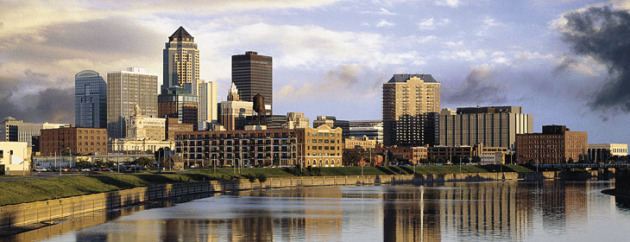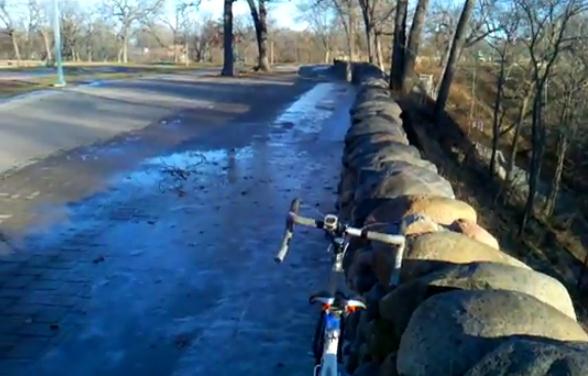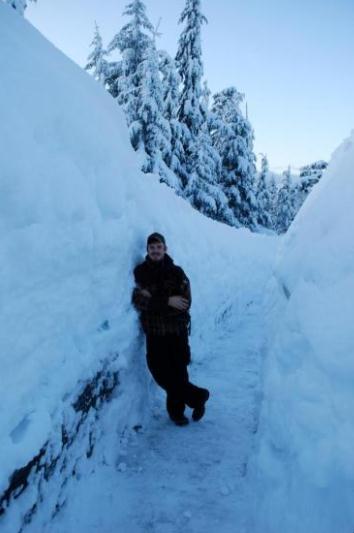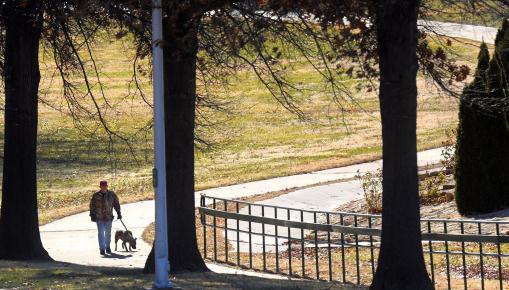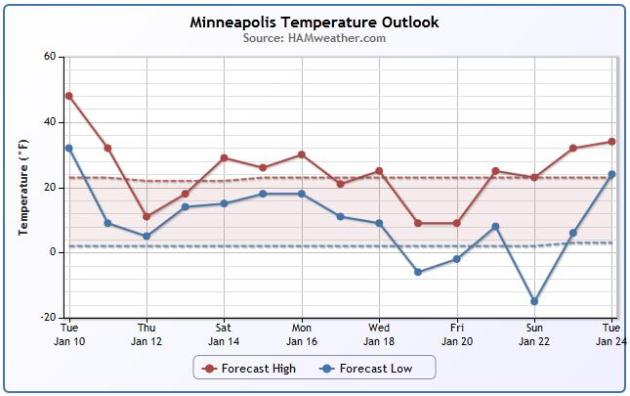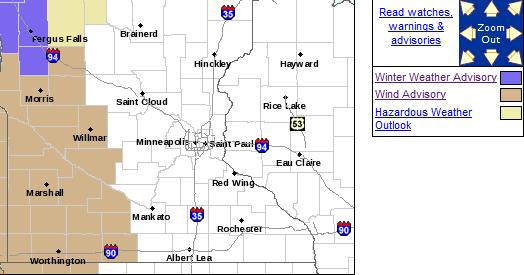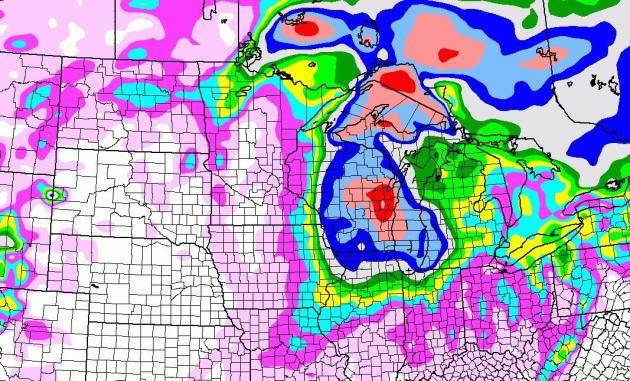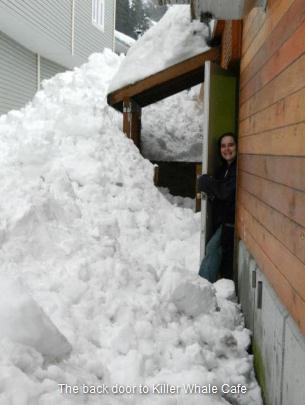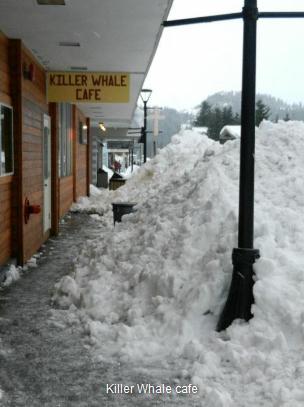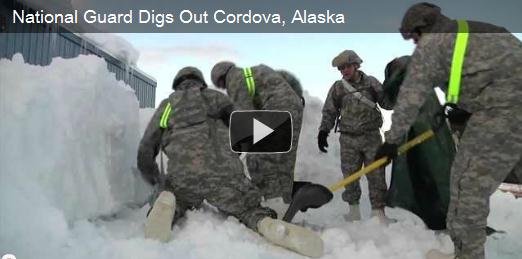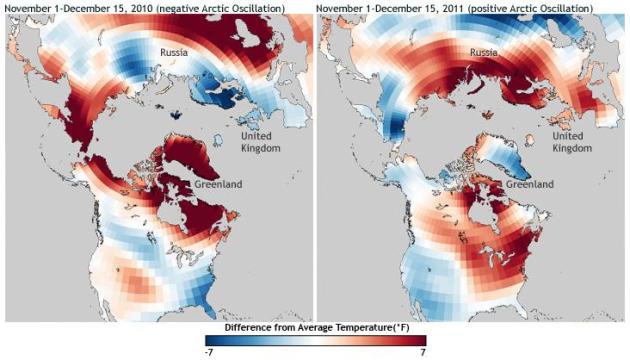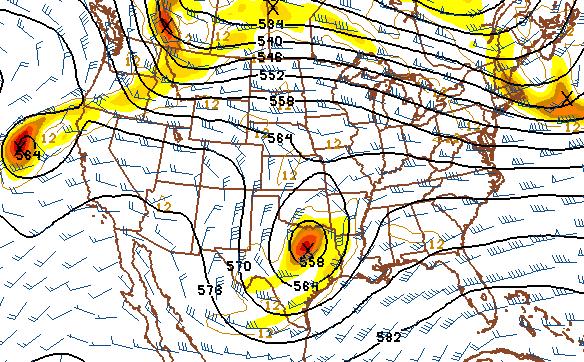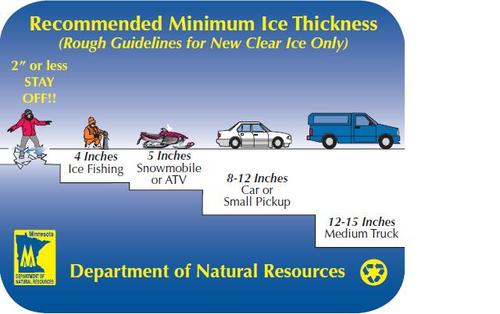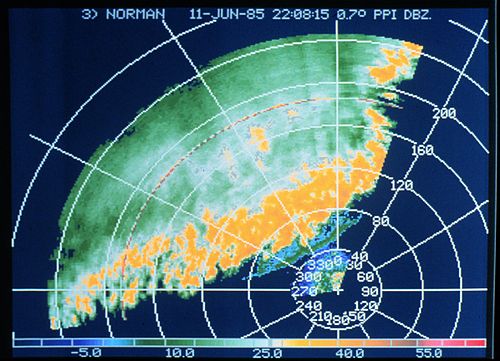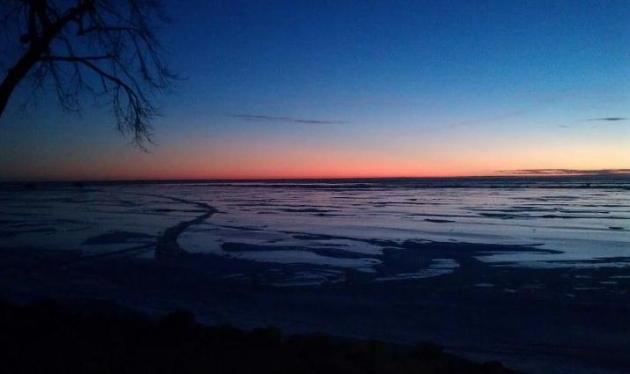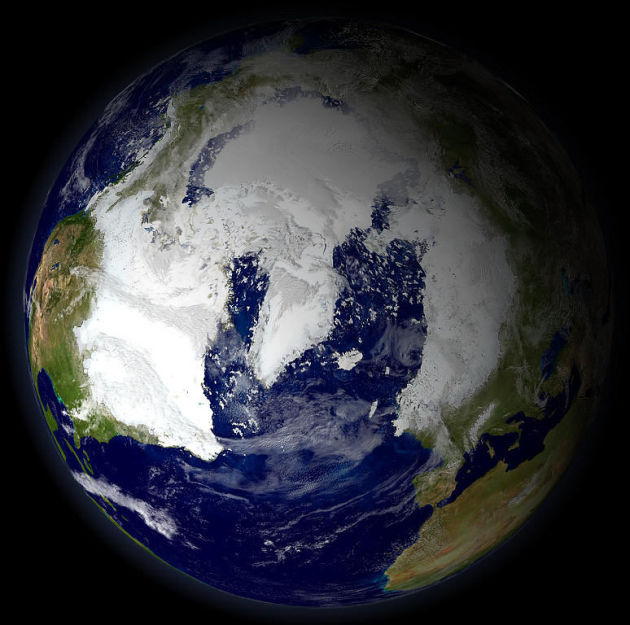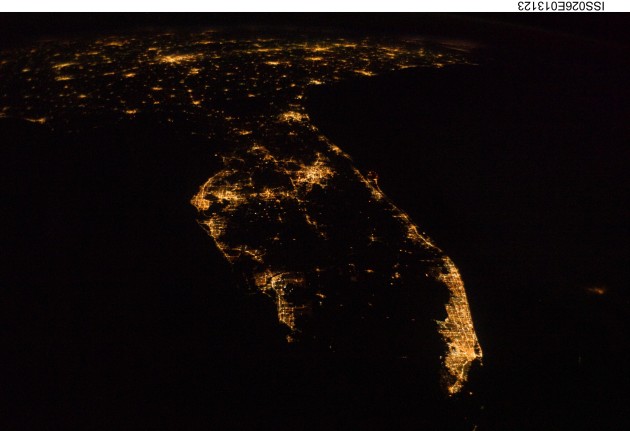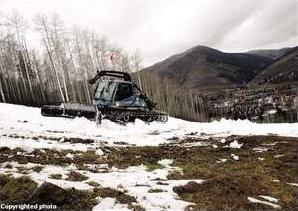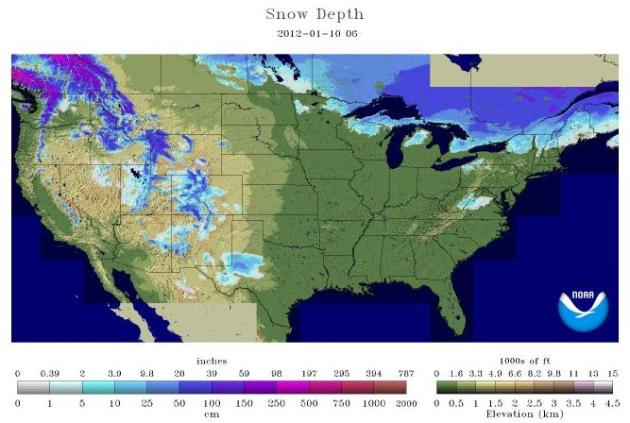Tuesday Records:
47 Duluth, breaking the old record of 42 set in 1928.
52 St. Cloud; old record was 49 in 1990.
57 Redwood Falls, breaks the old record of 52 in 1990.
54 Mankato, breaking the old record of 49 in 2002.
50 Alexandria, shattering old record of 47 in 1990.
53 Eau Claire; old record was 45 in 1980.
12"+ snow possible by Thursday from Green Bay to Milwaukee, Wisconsin. Details below.
4-8" snow predicted for Chicago. Thursday looks like the worst travel day for the Windy City. Details below.
Historic January Warm Front. This is what happens when an April-like airmass from the Pacific sweeps inland, breaking records left and right. Not counting yesterday, 2019 records since January 3, the vast majority record highs (red dots on the map above). To see an interactive map with detailed information from Ham Weather, click
here.
3rd warmest winter, to date, in Des Moines. Details below.
8 hours. Des Moines has experience only 8 hours of subzero wind chill so far this winter. According to Iowa State University, since 1933 only 1954 and 2002 had fewer hours of WC < 0.
Golfing Minnesota - on January 10? Meteorologist Ron Trenda sent me this photo - he played the executive, 9-hole Braemar course in Edina yesterday. 9 of the last 10 November were warm enough for golf in the metro area, but January? "Yup, a very rare opportunity", Ron told me. "I played one other time in January...January 8, 2003, when we hit 54. I'm one of the few duffers that has played golf in every month of the year in Minnesota." Wow, I didn't even know that was theoretically possible.
25 Mile Bike Ride....In January. WeatherNation meteorologist Aaron Shaffer shared a
YouTube clip of a rather ambitious bike ride (using his summer road bike) to a partially-frozen Minnehaha Falls yesterday.
"A study conducted at Boston's Children's Hospital determined that weather was a factor for more than 50% of migraine sufferers." - from an article on possible links between headaches and the weather below.
"Chance of Snow." You won't believe how much snow the town of Cordova, Alaska has seen in recent weeks. Photos below.
- The Alaskan National Guard has arrived to dig out the town of Cordova, which has seen 10ft (3m) of snow in a week.
- Drifts in the town of 2,000 trapped some residents in their homes.
- The scale of the mission is unprecedented for the US Coast Guard in the Arctic, Commander Greg Tlapa told the Associated Press.
* the BBC has more details
here.
"It is more easy to be wise for others than for ourselves." - Francois Duc de La Rochefoucauld
"It is very unusual to see a cold spell or warm spell of this significant last a month. On December 10th we were running about 3 degrees below normal and we finished December 8.1 degrees above normal. So far in January we are 14.3 degrees above normal. It will be very difficult to have a normal or below normal January, due to the strength of this warm spell. In fact, it will be hard to have a below normal winter in terms of temperatures. We would have to see a second half of January and all of February well below normal, and we see no indication of that happening."
- Dan Luna, MIC, local Twin Cities National Weather Service. Photo above courtesy of Star Tribune and AP.
Minnesota Businesses Are Seeing Red Ink In Brown Winter. An article from the
Star Tribune: "
Instead of moving snow, Blizzard Plowing owner David Melquist has pulled all his advertising for the year, killed his vacation plans and stopped doing maintenance on his equipment. For cross-country ski store owner Jan Guenther, this winter is the worst in 25 years. "This socks us flat on our face," she said. While some Minnesotans are reveling in the novelty of jogging in shorts in January, businesses that rely on snow to pay the bills are hoping that the weather turns cold and some of that white stuff falls. Ski shops, snowplowing businesses, contractors that remove ice dams and resorts are all suffering as the brown winter stretches on. Coming after last year's snowy winter and the near-constant business it brought, it's a shock."
Temperature Trends. With the exception of Sunday, temperatures should stay consistently below 32 F. through the end of next week. No more 40s or 50s in sight, looking out 2-3 weeks. So whatever snow does fall may just stick around for a few days. Graph above courtesy of Ham Weather.
A Potentially Bad Hair Day. The
local NWS office in Chanhassen has issued a Wind Advisory for much of western Minnesota for gusts over 40 mph. The greater the contrast in temperature - the stronger winds have to blow to keep the atmosphere in a state of equilibrium. Although only a couple inches of snow is predicted for the Red River Valley, high winds may create temporary white-out conditions.
Almost Plowable. The arrival of (much) colder air will wring out a light snowfall (you remember "snow", don't you?) Models are suggesting a coating to an inch, but the local NWS is being a bit more aggressive, forecasting closer to 1.6" snow by Thursday afternoon. Another "nuisance" snowfall is possible on Saturday, another coating, before we climb above freezing on Sunday.
A Significant Snowfall For Wisconsin? This is a little close for comfort - the latest NAM model prints out over a foot of snow from the Wisconsin Dells to near Milwaukee and Green Bay, most of that coming late tonight into Thursday. Even Chicago could pick up a cool 4-8" from a slow-moving Alberta Clipper, moisture wrapping all the way around this area of low pressure, approaching from the north on Thursday, causing the inches to add up. If you're traveling toward MKE or ORD Thursday you'll want to stay up on the latest forecasts. Map courtesy of WeatherCaster.
A Very Close Call. Yes, we're long overdue for a real snowfall - not sure this is "the one" though. Models suggest an inch of powdery by tonight for parts of the metro area, maybe 2" east of St. Paul, with some 6"+ amounts predicted east of Eau Claire.
Extended Outlook: Seasonably Cold. The (GFS) forecast above is for 500mb winds on January 26, showing a deepening trough of low pressure over the Midwest and Great Lakes, capable of spinning up a significant storm out east. Winds aloft are forecast to have more of a westerly than northwesterly component, meaning temperatures at, or even a few degrees above average, the last week of January.
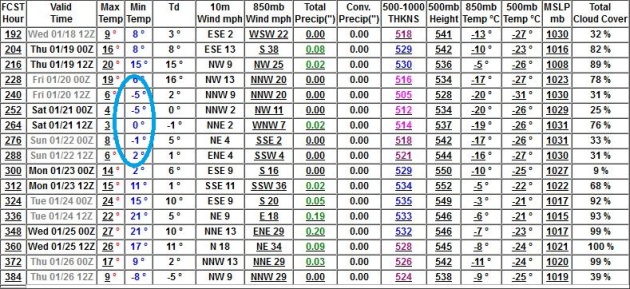 First Subzero Outbreak?
First Subzero Outbreak? It's not definite (it never is), but the GFS has been fairly the last few runs, pulling in what may be the first spell of negative numbers of the winter season into the Twin Cities. Circle your calendar: January 20-21. I don't see anything prolonged or record-setting though; temperatures bounce back up into the 20s, possibly the low 30s, by January 24-25.
Cordova (Alaska) Snowpocalypse 2012. {arts of Alaska have seen more snow than at anytime since the 1970s. Check out some of the amazing photos on this post from "
CordovaBuzz". I can't remember the last time I saw this much snow. Yes, Alaska is most definitely seeing a real winter: "
My dog loves snow. She rolls in it, eats it, buries herself, and chases snowballs until she can’t walk. To her, when it snows, it’s like the whole world is covered in one big edible toy. But for the rest of us, snow is only fun until… well… until it’s not. Here in Cordova, we’ve had a lot of snow lately. Over 15 feet, according to NOAA. We all heard about it… heck, most of us have been breaking our back for the last week shoveling it out of our driveways, sidewalks, doorways, lives. I’ve been skiing the heck out of some skiing here at Mt. Eyak, but there comes a point when enough snow is enough. Generally that point comes somewhere in the same region as 3 avalanches and some roof collapses. Thus far, Copper River Seafoods, Orca Adventure Lodge, and at least 6 residences have experienced cave-ins and it hasn’t stopped yet! We even made the newspapers, Anchorage news channel, and (most importantly) cable TV!"
Digging Out Cordova. With another major snowstorm imminent the risk of avalanches is significant. National Guard troops have been called in to help rescue stranded homeowners, and get food, medicine and other supplies to villagers. Click
here to see the YouTube clip.
- Alaska National Guardsmen began snow removal for operation ‘Deep Dig’ Jan. 9.
- The Guardsmen started clearing city buildings that were prioritized from an Emergency Operations Center (EOC) list.
- Some of the buildings included were the high school, hospital, and water plant.
Alaska National Guard Mobilizes. Portions of Alaska have been effectively shut off from the outside by a series of devastating snowstorms. Cordova, along the southern coast, has seen 15 FEET of snow, whipped into second story drifts - people unable to reach their front doors. The YouTube clip is
here; details:
- Over 50 Alaska National Guard members arrived in Cordova, AK Jan. 8 in response to a request from the State Emergency Operations Center (EOC).
- Members of the 761st Military Police Company spent the evening training in preparation for the upcoming mission.
- Subject matter experts were brought in to stress the importance of safety and teach the soldiers to properly use snow removal tools such as harnesses.
- The guard members are working through a prioritized list from the EOC and will start clearing city buildings as soon as possible.
So Far, Arctic Oscillation Favoring Mild Winter For Eastern USA. NOAA's
ClimateWatch Magazine has the update: "
One of the biggest influences on U.S. winter climate is the Arctic Oscillation, a natural seesawing of atmospheric pressure between the Arctic and the mid-latitudes of the North Pacific and North Atlantic Oceans. Because it isn’t predictable very far in advance, climate forecasters often describe the Arctic Oscillation as the “wild card” of the winter forecast. So far this winter, the Arctic Oscillation has been in its positive phase, playing the card that favors a milder winter in the eastern United States. The maps above show temperature patterns in late fall/early winter of 2010 (left) and 2011 (right). Places that were up to 7 degrees Fahrenheit warmer than the 1981-2000 average are dark red, while places that were up to 7 degrees Fahrenheit cooler than average are dark blue. Places where temperatures were near the long-term average are white."
This Winter's Weirdly Warm Weather Explained. Emily Sohn from
Discovery News delves into some of the reasons why it's been so mild, for so long: "
It felt more like March than January in many places last week, as more than 1,000 temperature records fell across the country during a winter that has been unusually warm and dry in many places. Bellingham, Wash., for example, saw a high of 60 in the first week of the year, while the mercury soared to a balmy 44 in Fargo, 61 in New York City, 72 in parts of Colorado and 79 in Tucson. In some regions of the Midwest, temperatures are 40 degrees higher than average. And snow covers just 19 percent of the country at the moment, compared to a usual coverage of about 50 percent at this time of year. "The whole lower 48 and much of southern Canada is feeling the effects of what I call 'Marchuary,'" said Paul Douglas, meteorologist and founder of Weather Nation, a weather outsourcing company in the Twin Cities, Minn. "It really is on the verge of being unprecedented meteorologically to be this warm for this long, this deep into winter."
PUBLIC INFORMATION STATEMENT
NATIONAL WEATHER SERVICE DES MOINES IA
543 PM CST TUE JAN 10 2012
...UPDATED STATISTICS FOR WARMTH SO FAR THIS WINTER...
THE METEOROLOGICAL WINTER TO DATE...DECEMBER 1ST THROUGH JANUARY
10TH...HAS BEEN CHARACTERIZED BY UNUSUALLY WARM TEMPERATURES AND
VERY LITTLE SNOWFALL ACROSS MUCH OF CENTRAL IOWA. MANY AREAS ARE
EXPERIENCING ONE OF THEIR WARMEST WINTERS-TO-DATE ON RECORD. THE
WARMEST WINTERS FROM DECEMBER 1ST THROUGH JANUARY 10TH...IN TERMS OF
AVERAGE TEMPERATURE...FOR SOME STATIONS ACROSS CENTRAL IOWA ARE AS
FOLLOWS:
----DES MOINES----
1. 1889-90 36.0 DEGREES
2. 2006-07 34.9 DEGREES
3. 2011-12 33.5 DEGREES
1881-82 33.5 DEGREES
4. 1965-66 33.0 DEGREES
December Weather Highlights:
• Several months of below average precipitation led to the development of moderate drought conditions across parts of California, Nevada and Oregon by the end of December.
• Pennsylvania and New Jersey recorded their wettest July through December periods on record.
• Alaska had its third warmest (8.7 degrees Fahrenheit above normal) and fifth wettest December on record.
* image above courtesy of NASA.
Survival App Aims To Help Winter Drivers. This (free) app seems like a pretty good idea to me; more details from
StatesmanJournal.com: "
FARGO, N.D. — When a powerful blizzard ripped through North Dakota last winter, hundreds of drivers were stranded as white-out conditions shuttered interstates spanning the state. Snow whipped up by wind marred the lines between pavement and grassy drop-offs, leaving some scared motorists unsure what to do. Two local software developers figured they could help. Bob Bertsch, an employee with the North Dakota State University Extension Service, and Jake Joraanstad, an NDSU computer engineering major, had just finished developing an app to help residents during floods when the blizzard hit in March, convincing them to shift their attention to winter disasters." More information on "Winter Survival Kit"
here.
Remember Safety First On Ice. Milwaukee's
Journal Sentinel has a timely story about ice safety. It's going to take a few weeks of temperatures (consistently) below freezing for many lakes to be safe again for walking/snowmobiling/ice fishing. I wouldn't even dream of driving a vehicle on area lakes until further notice: "
One of the axioms of the season is that no ice is completely safe. The mild weather that has marked the winter of 2011-'12 has made ice even less predictable. Many ice safety measures are widely practiced, others less so. All are worthy of review. Todd Schaller, recreation safety chief for the Department of Natural Resources, passed along the following ice safety tips: Dress for the conditions. That means the proper clothing and equipment. Please include a U.S. Coast Guard-approved personal flotation device (vest or coat) that will help you stay afloat and slow body heat loss should you fall in. Extra mittens and gloves should be standard so you always have a dry pair. Wear ice creepers on your boots to help prevent slips. Contact local sport shops to ask about ice conditions on the lake or river you want to fish."
The Link Between Your Headaches And The Weather. I've been getting some pretty nasty headaches in recent days - wondering (out loud) if the weather is a trigger.
Qualityhealth.com has a timely article: "
Many headache sufferers swear there's a link between their pain and the weather. Many doctors, however, disagree and think its nothing more than folklore. Now, studies are beginning to show a correlation between certain weather patterns and different types of headaches. A study conducted at Boston's Children's Hospital determined that weather was a factor for more than 50 percent of migraine sufferers. More than 60 percent, however, thought that weather changes contributed to their headaches. This led researchers to determine that while weather is certainly an important contributor to pain, more patients believe the weather causes their pain when it actually doesn't."
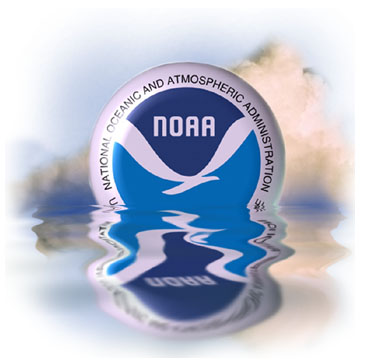 January 9 Records Around The USA
January 9 Records Around The USA (courtesy of NOAA and Julie Gaddy at Earth Networks):
Montana
Glasgow 56
South Dakota
Pierre 57
Huron 57
Mobridge 55
Aberdeen 53
North Dakota
Dickinson 54
Bismarck 53
Jamestown 52
Williston 51
Fargo 51
Minot 50
Minnesota
St. Cloud 49
Minneapolis 49 *tie
Rochester 46 *tie
Duluth 45
Southern Plains RAIN/SNOW
Texas
Houston- Hobby Airport 4.06"
Lufkin – 2.75"
San Angelo SNOW – 2.6."/1.38 inches liquid (rain changed to snow)
Dallas-Fort Worth 1.31"
Midland SNOW – 10.6"/ 0.70 inches liquid water equivalent (mostly snow, some rain very early in event)
Louisiana
Lake Charles 6.26"
Lafayette 3.25"
New Iberia 2.72"
Volcano Alert. Details: "
Chile’s government declared a state of alert following a series of tremors at the Lascar volcano in the northern region of Antofagasta, home to some of the world’s largest copper mines."
Why The Future Of TV Won't Be Here Soon. Is this the year of iTV? I'm not holding my breath. Here's an interesting post from
All Things Digital: "
This is the year for many big pronouncements about The Future Of TV, and we’re hearing the first round this week at the Consumer Electronics Show. Here’s how I’m sorting through the deluge: I’m ignoring almost all of it. Instead, I’m focusing on the ones that promise to bring me the TV I want to see, when I want to see it, without charging me a fortune. And without making me pay for stuff I don’t care about. Try it yourself. See? Things get quiet in a hurry. All that other stuff that everyone is talking about right now — new ways to get Web video onto your TV set, new ways to chat up your friends while you watch TV, etc. — is sort of interesting. Maybe it eventually turns into something really interesting."
Honda NSX Hybrid Supercar Concept. From
gizmag.com: "
Honda made its first attempt at a production supercar, the NSX, 21 years ago, and we've been waiting for the follow-up ever since. At Detroit today, we saw the genesis of the next NSX supercar, slated for showrooms within three years. No power or weight figures were mentioned but like the prior NSX, its primary engine will be a mid-mounted V-6. Honda claims the NSX's Sport Hybrid SH-AWD® (Super Handling All Wheel Drive™) hybrid system will deliver handling performance unmatched by previous AWD systems."
How To Make TV Better. More episodes of "Wives of New Jersey"? Possibly, but I'm betting that 3-D will be a dud (who wants to wear those goofy glasses anyway?). Samsung just unveiled their new 55" Super OLED TV; much brighter, more colorful, amazingly thin. How many months until Christmas? I think I need one of these, for research purposes, of course. The geeks over at
gizmodo.com were pretty amped up about this one: "
The first thing your brain realizes after your eyes recover from the explosive eyegasm is that the picture looks like it's floating in mid air. That's because the bezel is supermodel-who's-not-eaten-in-weeks thin, essentially unnoticeable, letting your picture appear frameless. The blacks are darker than night, the colors are deliciously vivid and to be honest, it looks better than real life. It's the best thing my eyes have ever seen. I want this in my living room so much I seriously considered the legal ramifications if I somehow stole it."
Your Smartphone Is One Step Closer To Becoming Invincible. This is good news, should your iPhone ever fall into the iCommode. Details from
mashable.com: "
It seems technology companies are finally tuning in to that most basic of tech consumer problems: dropping devices in the toilet. Unveiled this week at CES, Liquipel is a clear coating that protects smartphones from dying in a watery grave. And if Liquipel can connect with enough smartphone vendors this week at CES, it could come with your next phone. The new coating uses nanotechnology vapors to seep into every part of your phone and protect it from water damage. The coating is “1,000 times thinner than a human hair,” says Danny McPhail, co-president at Liquipel. The super-thin coating does not effect the look or functionality of the phone."

 Fast Food: Ads Vs. Reality.
Fast Food: Ads Vs. Reality. I'm sure glad someone did this - and I guess none of us should be shocked by the results. Things just look so much better on TV, especially a Samsung 55" Super OLED TV.
Alphalia.com has the fascinating story: "
So, I went to some fast food places (I won’t say “restaurants”, just “places”), and picked up burgers and tacos, so I could compare them with the ads. (I’m always on the hunt for little projects like this. Stoked.) I brought the food home, tossed it into my photography studio, and did ad-style shoots, with pictures of the official ads on my computer next to me, so I could match the lighting and angles. People around the world know fast food as one of the most reliable distributors of disappointment ever produced by the business world. We know that if we ever feel the need to complain about something, we can just grab a page out of a coupon booklet, adorned in pictures of juicy burgers, go to a fast food place, then have a party. Why, the places themselves usually plaster their walls with pictures of juicy burgers – often hanging right over your table – so you need only open your eyes to find something to compare your food with, while you eat it. Needless to say, the results of my little project were unsurprising… which shouldn’t be a surprise."
The Future Of The Newspaper - A Real Page-Turner. This is a very funny
YouTube clip - worth a click.
"Life is like a coin. You can spend it any way you wish, but you can only spend it once." - Lillian Dickson
"Life is a cement trampoline." - Howard Nordberg
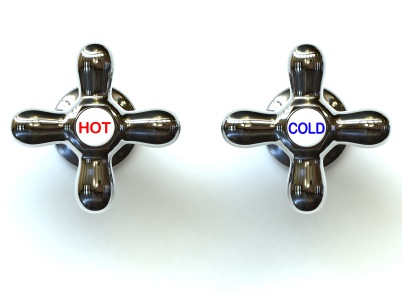
 Mille Lacs Sunset.
Mille Lacs Sunset. Thanks to Annie Fahrenkamp for passing this one along. Very nice.
Reality Check
"Life is a concrete trampoline", mused Howard Nordberg, who was never accused of being an optimist. But I know the feeling. Our super-sized, historic January thaw is history; Minnesotans still buzzing about yesterday's April-like 50s. Since December 1: 30 days above freezing, 13 days above 40. Remarkable.
Back to "normal" will feel like a cold smack across the face. And the arrival of seasonably cold air sets off a smear of light "snow" later today; a quick inch can't be ruled out, with some 6 inch plus amounts over central and northern Wisconsin.
Amazingly persistent west winds aloft will (finally) buckle, allowing Canadian air to surge south. In spite of a brief thaw on Sunday temperatures should be consistently below freezing through late January. That said, it'll take a few weeks for ice on area lakes to become stable and totally safe again.
Northwest winds aloft won't favor any big snowstorms, but a series of beefy clippers may drop "a few" inches of snow the third week of January.
Winter weather lovers: there's a light at the end of our brown, lukewarm tunnel. For everyone else: there's growing confidence this will be one of the easiest Januaries in recent history.
* Photo above courtesy of AP.
Greenland Ice Sheet Getting Darker. From
NOAA Climate Services:
"Map (above) of changes in the percent of light reflected by the Greenland Ice Sheet in summer (June-July-August) 2011 compared to the average from 2000-2006. Virtually the entire surface has grown darker due to surface melting, dust and soot on the surface, and temperature-driven changes in the size and shape of snow grains. Map by NOAA’s climate.gov team, based on NASA satellite data processed by Jason Box, Byrd Polar Research Center, the Ohio State University."
"Global Weirding". Here's an interesting perspective (and interview) from
ESPN: "
In 2007, I attended a slideshow at Squaw Valley, Calif., that was presented by Alison Gannett, the 1998 World Freeskiing Champion and the founder of the Save Our Snow Foundation. Shortly after the release of the documentary film "An Inconvenient Truth," about the global climate crisis, Gannett was selected to train with former Vice President Al Gore. The result was a comprehensive series of slideshows about global warming directed toward a snow-loving audience. Her presentation struck a chord with me and it was the first time I heard the term "global weirding." It's now mid-January in a balmy and virtually snow-less Lake Tahoe and I can't help but wonder, is this what Alison Gannett was talking about? I called her up to ask.
One of the main points that you made during your slideshow was that the first thing we would see and experience with global warming was something that you called "global weirding." Please explain.
I found that people couldn't relate to "climate change" and that the term "global warming" left people confused, so I switched to "global weirding." That term more accurately describes what is happening -- while the planet is actually warming, the actual result is extreme weather. Global temperature increases result in really strange local weather -- record low temperatures, record heat waves, more windy weather, record droughts, and yes, even record snowstorms. As the air warms, it can hold more moisture, so in the short term we can have larger snowfalls. In the long term, more of those storms will fall as rain."
* Photo of Squaw Valley, California above courtesy of Jason Abraham.
Michael Mann Defends Computer Climate Models. From
Scientific American: "
Fair warning: the following is more than 60 seconds, and it’s about climate change. "Even in high school my idea of a good time was sitting in front of a computer and solving problems." Climatologist Michael Mann. “And that has always been true. I love using computational methods to learn about the way, hopefully, the way the world actually works.” Some critics, such as physicist Freeman Dyson, charge that climate change science relies too much on such computer models. And even worse, that the climate scientists behind them are too much in love with their computational creations. Such mathematical approximations are crude, failing to capture the real world climate impacts of a cloud, for example. That makes them useful for understanding climate but not for predicting climate change, Dyson has argued. I asked Mann in a recent phone interview how he responded to such arguments."
No Virginia, We Didn't Avoid Another Ice Age. Wait, I thought warming wasn't taking place, right? But now some of the deniers are claiming that all that CO2 from coal-fired power plants is "saving us from the next Ice Age". Hmmm.
Climatecrocks.com takes a look at the latest round of scientific disinformation: "
Did you hear the one about how great it is that we are emitting heat trapping gases? Turns out, the story goes, that we are warding off an impending ice age. Thank God for Peabody Coal!! Notwithstanding the obviously inconsistent narrative (greenhouse gases have no effect/thank god they’re saving us from an ice age), this is yet another of those peripheral news stories that takes on a life of its own thru the climate denial magic mirror megaphone. Someone asked me this at a sports bar last night, so apparently its gotten a little traction. Since this has potential to be another pesky BS denial meme, let’s nip it in the bud right now. First listen to the BBC Today Show interview with study author, Luke Skinner, above. Then read on."
Global Warming: Study Shows Big Shift In Alpine Plants. The story from the
Summit County Citizens Voice: "
SUMMIT COUNTY — Researchers working in the Alps of Europe say they’ve measured significant shifts in high elevation plant communities toward species that favor warmer temperatures. The changes occurred in the short span of just 10 years, suggesting that global warming is already having a substantial impact on alpine plant communities. “The transformation of plant communities on a continental scale within less than a decade can be considered a rapid ecosystem response to ongoing climate warming,” the researchers wrote. “Although the signal is not statistically significant for single mountain regions, it is clearly significant when data throughout Europe are pooled.” Scientists from 13 countries pooled their research efforts to report clear and statistically significant evidence of a continent-wide warming effect on mountain plant communities."
South Florida Prepares For Rising Seas With Plans For Protecting Roads, Wells And Property. Orlando's
Sun Sentinel newspaper has the details: "
PALM BEACH COUNTY, Fla. - A battle plan for an anticipated assault by seawater has been drafted by four South Florida counties, attempting to protect one of the nation's most vulnerable regions from the impact of climate change. The proposal by Broward, Palm Beach, Miami-Dade and Monroe counties calls for 108 actions to deal with rising sea levels and other consequences of global warming. Among the steps: Redesigning low-lying roads to keep them above water, restricting development in vulnerable areas and relocating drinking-water wells inland to protect them from contamination by salt water.
* Photo courtesy of NASA.
Climate Change's Threat To Ski Industry Spurs Action. Here's a story from
summitdaily.com: "
At the start of the ski season, Arapahoe Basin chief operating officer Alan Henceroth announced his ski area was moving away from purchasing renewable energy credits and instead had invested in retrofitting the existing base-area lighting system with energy-efficient bulbs. It's a justifiable move to leaders in the field, one all of Summit County's resorts have taken in the recent past in favor of making on-the-ground operational changes to be more energy, water and waste conscious. To Auden Schendler, though, “operational greening” isn't enough action for the ski industry, which he says is increasingly affected by climate change. The vice president of sustainability for Aspen Skiing Company argues the ski industry should create a voice that lobbies Washington, D.C. for legislation that protects its business."
Colorado Sees Worst Snow Drought Since Early 80s, Foreshadowing Water Shortages And Potential Wildfires. The story from
Think Progress: "
Last year, Colorado saw a record snowfall, with 525 inches falling during ski season. But this year, while massive snowfalls in Alaska have collapsed roofs, the state is suffering from the worst snow drought since the early 1980s. “For the first time in 30 years, a lack of snow has not allowed us to open the back bowls in Vail as of January 6, 2012, and, for the first time since the late 1800s, it did not snow at all in Tahoe in December,” said Vail Resorts CEO Rob Katz. The state’s ski industry is hurting, but a coming water shortage caused by the lack of snow could be worse, according to the Colorado Independent: Ski industry woes aside, state water watchers and firefighters are nervously eyeing the miniscule mountain snowpack, which supplies so much of the water used by Front Range cities."
Mango Season Delayed Due To Erratic Climate, Cyclone Thane.
Times of India has more details: "
There is some disappointing news for mango lovers as the crop is likely to be delayed this year. Cyclone Thane and indifferent weather have affected flowering and could negatively impact the crop. Mango is cultivated in frost-free tropical and sub-tropical climates. More than a third of the world's mangoes is produced in India and Krishnagiri district is a major producer of some of the most popular varieties. According to the district's horticulture department, mango trees have been planted on 40,000 hectares of land in the district. About 7.3 tonnes of mangoes are produced per hectare. The fruit is harvested in the middle of February. In March/April, it is usually available in market." Photo courtesy of AP.


